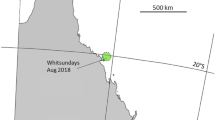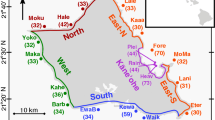Abstract
Coral reef cryptofauna are a diverse group of metazoan taxa that live within intra- and inter-skeletal voids formed by framework structures. Despite a hypothesized high biomass and numerous trophic roles, they remain uncharacterized relative to exposed reef communities. Motile cryptofauna were sampled from live coral colonies and dead frameworks typifying four successive levels of degradation on an eastern Pacific pocilloporid reef. Abundances and biomass were higher on live versus dead corals habitats. The density of cryptofauna per volume substrate was highest on dead coral frameworks of intermediate degradation, where complex eroded substrates provide abundant shelters. These data have important and far-reaching ramifications for how the diverse multispecies assemblages that are reef ecosystems will respond to anthropogenic stressors such as those associated with climate change. Extreme levels of coral mortality, bioerosion, and habitat destruction will lead to impairment and eventually loss of ecosystem functions.









Similar content being viewed by others
References
Ackerman JL, Bellwood DR (2000) Reef fish assemblages: a reevaluation using enclosed rotenone stations. Mar Ecol Prog Ser 206:227–237
Alldredge AL, King JM (1977) Distribution, abundance, and substrate preferences of demersal reef zooplankton at Lizard Island Lagoon, Great Barrier Reef. Mar Biol 41:317–333
Alvarez-Filip L, Dulvy NK, Gill JA, Côté IM, Watkinson AR (2009) Flattening of Caribbean coral reefs: region-wide declines in architectural complexity. Proc R Soc Lond B 276:3019–3025
Bailey-Brock JH, Brock RE, Kam A, Fukunaga A, Akiyama H (2007) Anthropogenic disturbance on shallow cryptofaunal communities in a marine life conservation district on Oahu, Hawaii. Int Rev Hydrobiol 92:291–300
Baker AC, Glynn PW, Riegl B (2008) Climate change and coral reef bleaching: an ecological assessment of long-term impacts, recovery trends and future outlook. Est Coast Shelf Sci 80:435–471
Bakus GJ (1966) Some relationships of fishes to benthic organisms on coral reefs. Nature 210:280–284
Brock RE, Brock JH (1977) A method for quantitatively assessing the infaunal community in coral rock. Limnol Oceanogr 22:948–951
Brock RE, Smith SV (1983) Response of coral reef cryptofaunal communities to food and space. Coral Reefs 1:179–183
Buss LW, Jackson JBC (1981) Planktonic food availability and suspension-feeder abundance: evidence of in situ depletion. J Exp Mar Biol Ecol 49:151–161
Caley MJ, Buckley KA, Jones GP (2001) Separating ecological effects of habitat fragmentation, degradation, and loss on coral commensals. Ecology 82:3435–3448
Carpenter RC (1997) Invertebrate predators and grazers. In: Birkeland C (ed) Life and death of coral reefs. Chapman and Hall, New York, pp 198–229
Coen LD (1988) Herbivory by Caribbean majid crabs: feeding ecology and plant susceptibility. J Exp Mar Biol Ecol 122:257–276
Coker DJ, Pratchett MS, Munday PL (2009) Coral bleaching and habitat degradation increase susceptibility to predation for coral-dwelling fishes. Behav Ecol 20:1204–1210
Dall W, Smith DM, Moore LE (1991) Biochemical composition of some prey species of Penaeus esculentus Haswell (Penaeidae: Decapoda). Aquaculture 96:151–166
Depczynski M, Bellwood DR (2003) The role of cryptobenthic reef fishes in coral reef trophodynamics. Mar Ecol Prog Ser 256:183–191
Edwards A, Emberton H (1980) Crustacea associated with the scleractinian coral, Stylophora pistillata (Esper), in the Sudanese Red Sea. J Exp Mar Biol Ecol 42:225–240
Enochs IC, Hockensmith G (2009) Effects of coral mortality on the community composition of cryptic metazoans associated with Pocillopora damicornis. Proc 11th Int Coral Reef Symp 26:1368–1372
Falter JL, Sansone FJ (2000) Shallow pore water sampling in reef sediments. Coral Reefs 19:93–97
Fauchald K, Jumars PA (1979) The diet of worms: a study of polychaete feeding guilds. Oceanogr Mar Biol Ann Rev 17:193–284
Gardner TA, Côté IM, Gill JA, Grant A, Watkinson AR (2003) Long-term region-wide declines in Caribbean corals. Science 301:958–960
Garpe KC, Yahya SAS, Lindahl U, Ohman MC (2006) Long-term effects of the 1998 coral bleaching event on reef fish assemblages. Mar Ecol Prog Ser 315:237–247
Garrett P, Smith DL, Wilson AO, Patriquin D (1971) Physiography, ecology, and sediments of two Bermuda patch reefs. J Geol 79:647–668
Ginsburg RN (1983) Geological and biological roles of cavities in coral reefs. In: Barnes D (ed) Perspectives on coral reefs. Australian Institute of Marine Science, Townsville, pp 148–153
Glynn PW (1980) Defense by symbiotic Crustacea of host corals elicited by chemical cues from predator. Oecologia 47:287–290
Glynn PW (1983) Increased survivorship in corals harboring crustacean symbionts. Mar Biol Lett 4:105–111
Glynn PW (2006) Fish utilization of simulated coral reef frameworks versus eroded rubble substrates off Panama, eastern Pacific. Proc 10th Int Coral Reef Symp 1:250–256
Glynn PW (2011) Fine-scale interspecific interactions on coral reefs: functional roles of small and cryptic metazoans. In: Lang M (ed) Research and discoveries: the revolution of science through SCUBA, Smithsonian Institution
Glynn PW, Macintyre (1977) Growth rate and age of coral reefs on the pacific coast of Panama. Proc 3rd Int Coral Reef Symp 2:251–259
Graham NAJ, Wilson SK, Jennings S, Polunin NVC, Robinson J, Bijoux JP, Daw TM (2007) Lag effects in the impacts of mass coral bleaching on coral reef fish, fisheries, and ecosystems. Conserv Biol 21:1291–1300
Graham NAJ, Wilson SK, Pratchett MS, Polunin NVC, Spalding MD (2009) Coral mortality versus structural collapse as drivers of corallivorous butterflyfish decline. Biodivers Conserv 18:3325–3336
Grassle JF (1973) Variety in coral reef communities. In: Jones OA, Endean R (eds) Biology and geology of coral reefs II. Biology 1. Academic Press, New York, pp 247–270
Griffiths CL, Blaine MJ (1988) Distribution, population structure and biology of stomatopod Crustacea off the west coast of South Africa. S Afr J Mar Sci 7:45–50
Grottoli AG, Rodrigues LJ, Palardy JE (2006) Heterotrophic plasticity and resilience in bleached corals. Nature 440:1186–1189
Grutter AS, Pickering JL, McCallum H, McCormick M (2008) Impact of micropredatory gnathiid isopods on young coral reef fishes. Coral Reefs 27:655–661
Guzmán HM (1988) Distribución y abundancia de organismos coralívoros en los arrecifes coralinos de la Isla del Caño, Costa Rica. Rev Biol Trop 36:191–207
Hobson ES (1974) Feeding relationships of teleostean fishes on coral reefs in Kona, Hawaii. Fish Bull 72:915–1031
Hobson ES (1991) Trophic relationships of fishes specialized to feed on zooplankters above coral reefs. In: Sale P (ed) The ecology of fishes on coral reefs. Academic Press, San Diego, pp 69–95
Hughes TP, Baird AH, Bellwood DR, Card M, Connolly SR, Folke C, Grosberg R, Hoegh-Guldberg O, Jackson JBC, Kleypas J, Lough JM, Marshall P, Nyström M, Palumbi SR, Pandolf JM, Rosen B, Roughgarden J (2003) Climate change, human impacts, and the resilience of coral reefs. Science 301:929–933
Hutchings PA, Weate PD (1977) Distribution and abundance of cryptofauna from Lizard Island, Great Barrier Reef. Mar Res Indones 17:99–112
Jiménez C (1996/1997) Coral colony fragmentation by whitetip reef sharks at Coiba Island National Park, Panamá. Rev Biol Trop 44/45:698–700
Klumpp DW, McKinnon AD, Mundy CN (1988) Motile cryptofauna of a coral reef: abundance, distribution and trophic potential. Mar Ecol Prog Ser 45:95–108
Kohler KE, Gill SM (2006) Coral Point Count with Excel extensions (CPCe): a Visual Basic program for the determination of coral and substrate coverage using random point count methodology. Comp Geosci 32:1259–1269
Knudsen JW (1967) Trapezia and Tetralia (Decapoda, Brachyura, Xanthidae) as obligate ectoparasites of pocilloporid and acroporid corals. Pac Sci 21:51–57
Kobluk DR (1988) Cryptic faunas in reefs: ecology and geologic importance. Palaios 3:379–390
Kohn AJ (1983) Microhabitat factors affecting abundance and diversity of Conus on coral reefs. Oecologia 60:293–301
Kohn AJ, Leviten PJ (1976) Effect of habitat complexity on population density and species richness in tropical intertidal predatory gastropod assemblages. Oecologia 25:199–210
Kohn NP, Word JQ, Niyogi DK, Ross LT, Dillon T, Moore DW (1994) Acute toxicity of ammonia to four species of marine amphipod. Mar Environ Res 38:1–15
Lang JC, Chornesky EA (1990) Competition between scleractinian reef corals: a review of mechanisms and effects. In: Dubinsky Z (ed) Coral reefs. Ecosystems of the world, vol 25. Elsevier, Amsterdam, pp 209–252
Lewis JB, Snelgrove PVR (1990) Corallum morphology and composition of crustacean cryptofauna of the hermatypic coral Madracis mirabilis. Mar Biol 106:267–272
McCloskey LR (1970) The dynamics of the community associated with a marine scleractinian coral. Int Rev Gesamten Hydrobiol Hydrogr 55:13–81
Moran DP, Reaka ML (1988) Bioerosion and availability of shelter for benthic reef organisms. Mar Ecol Prog Ser 44:249–263
Opitz S (1996) Trophic interactions in Caribbean coral reefs. ICLARM Technical Report 43. ICLARM, Manila
Ott B, Lewis JB (1972) The importance of the gastropod Coralliophila abbreviata (Lamarck) and the polychaete Hermodice carunculata (Pallas) as coral reef predators. Can J Zool 50:1651–1656
Peyrot-Clausade M (1980) Motile cryptofauna of Tuléar reef flats. Mar Biol 59:43–47
Porter JW (1974) Zooplankton feeding by the Caribbean reef-building coral Montastrea cavernosa. Proc 2nd Int Coral Reef Symp 1:111–125
Randall JE (1967) Food habits of reef fishes of the West Indies. Stud Trop Oceanogr 5:665–847
Reaka ML (1987) Adult-juvenile interactions in benthic reef crustaceans. Bull Mar Sci 41:108–134
Ricciardi A, Bourget E (1998) Weight-to-weight conversion factors for marine benthic macroinvertebrates. Mar Ecol Prog Ser 163:245–251
Richter C, Wunsch M (1999) Cavity-dwelling suspension feeders in coral reefs—a new link in reef trophodynamics. Mar Ecol Prog Ser 188:105–116
Richter C, Wunsch M, Rasheed M, Kötter I, Badran MI (2001) Endoscopic exploration of Red Sea coral reefs reveals dense populations of cavity-dwelling sponges. Nature 413:726–730
Rothans TC, Miller AC (1991) A link between biologically imported particulate organic nutrients and the detritus food web in reef communities. Mar Biol 110:145–150
Rotjan RD, Lewis SM (2008) Impact of coral predators on tropical reefs. Mar Ecol Prog Ser 367:73–91
Scheffers SR, Nieuwland G, Bak RPM, van Duyl FC (2004) Removal of bacteria and nutrient dynamics within the coral reef framework of Curaçao (Netherlands Antilles). Coral Reefs 23:413–422
Scheffers SR, van Soest RWM, Nieuwland G, Bak RPM (2010) Coral reef framework cavities: is functional similarity reflected in composition of the cryptic macrofaunal community? Atoll Res Bull 583:1–24
Shirayama Y, Horikoshi M (1982) A new method of classifying the growth form of corals and its application to a field survey of coral-associated animals in Kabira Cove, Ishigaki Island. J Oceanogr Soc Jpn 38:193–207
Simberloff D, Dayan T (1991) The guild concept and the structure of ecological communities. Annu Rev Ecol Syst 22:115–143
Steger R (1987) Effects of refuges and recruitment on gonodactylid stomatopods, a guild of mobile prey. Ecology 68:1520–1533
Stimson J (1990) Stimulation of fat-body production in the polyps of the coral Pocillopora damicornis by the presence of mutualistic crabs of the genus Trapezia. Mar Biol 106:211–218
van Duyl FC, Scheffers SR, Thomas FIM, Driscoll M (2006) The effect of water exchange on bacterioplankton depletion and inorganic nutrient dynamics in coral reef cavities. Coral Reefs 25:23–36
Vinogradov AP (1953) The elementary chemical composition of marine organisms. Mem Sears Found Mar Res 2:1–647
Vivien ML (1973) Contribution a la connaissance de l’éthologie alimentaire de l’ichtyofaune du platier interne des récifs coralliens de Tuléar (Madagascar). Tethys Suppl 5:221–308
Vytopil E, Willis BL (2001) Epifaunal community structure in Acropora spp. (Scleractinia) on the Great Barrier Reef: implications of coral morphology and habitat complexity. Coral Reefs 20:281–288
Zvuloni A, Artzy-Randrup Y, Stone L, van Woesik R, Loya Y (2008) Ecological size-frequency distributions: how to prevent and correct biases in spatial sampling. Limnol Oceanogr Methods 6:144–152
Acknowledgments
The author is grateful for the unwavering support, expert advice, and inspiring knowledge of Peter W. Glynn. Assistance with fieldwork was provided by L. Toth, V. Brandtneris, D. Manzello, and R. Muthukrishnan. J. Afflerbach, V. Brandtneris, I. Chambers, A. Goodson, A. Gracie, D. Graham, A. Jung, J. Kelly, N. Kraft, L. O’Neill, A. Mallozzi, A. Pflaumer, and S. Thompson helped process specimens. The critical reviews of P. Glynn, A. Bakun, C. Langdon, D. Lirman, D. Manzello, and B. Riegl greatly enhanced the quality of this paper. Financial support for this research was provided by NSF grant OCE-0526361 to P. Glynn and by the American Museum of Natural History Lerner-Gray Fund.
Author information
Authors and Affiliations
Corresponding author
Additional information
Communicated by R. H. Richmond.
Rights and permissions
About this article
Cite this article
Enochs, I.C. Motile cryptofauna associated with live and dead coral substrates: implications for coral mortality and framework erosion. Mar Biol 159, 709–722 (2012). https://doi.org/10.1007/s00227-011-1848-7
Received:
Accepted:
Published:
Issue Date:
DOI: https://doi.org/10.1007/s00227-011-1848-7




